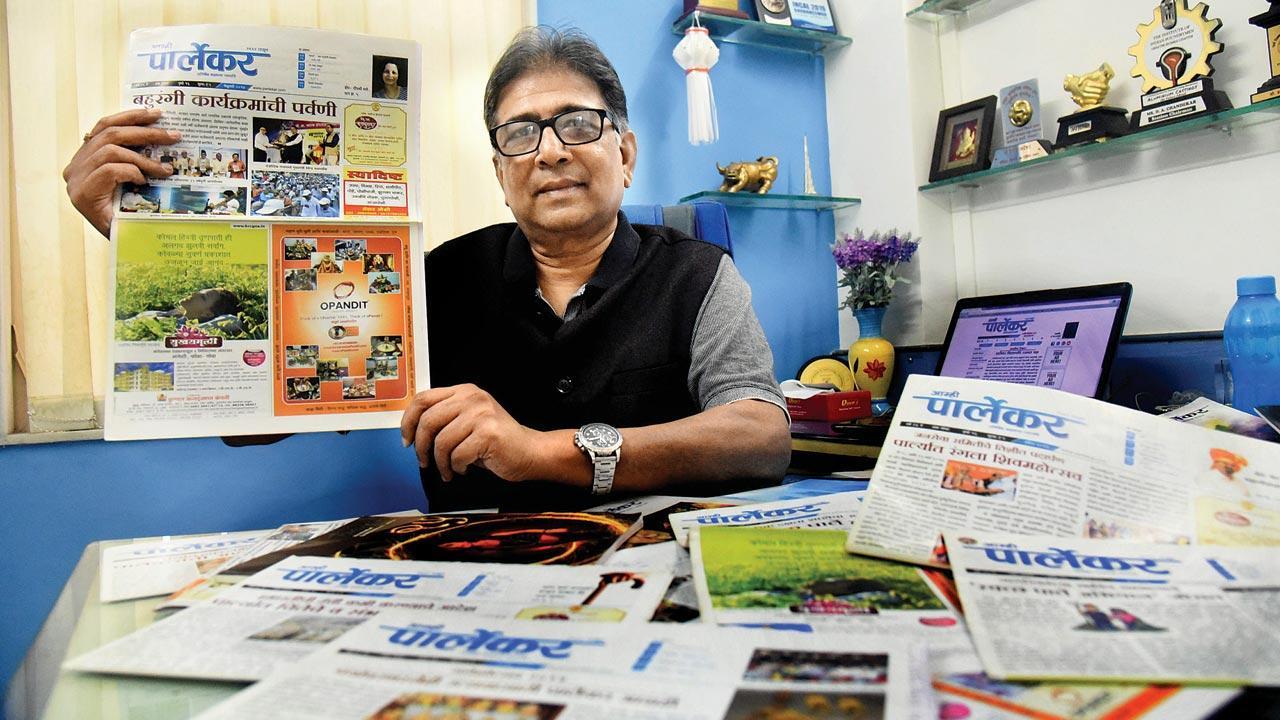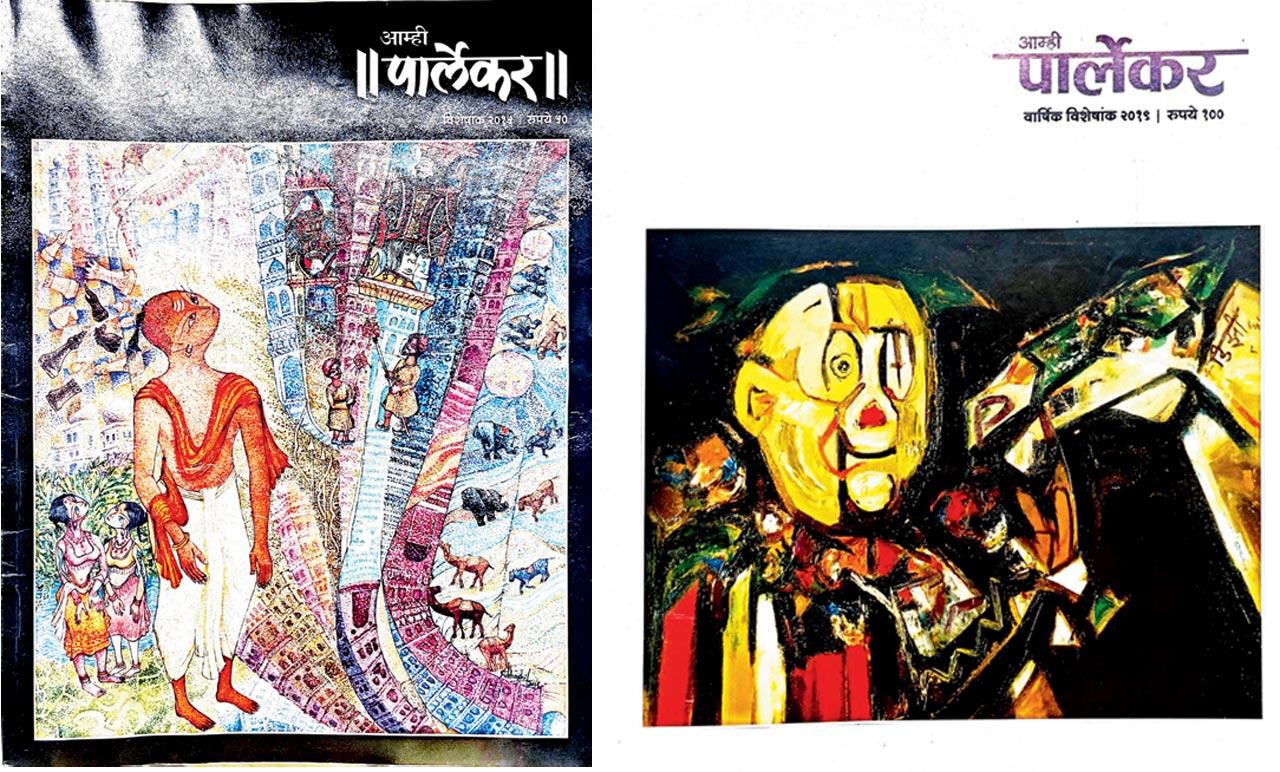A newspaper started 30 years ago and dedicated to the socio-cultural issues of Vile Parle has continued to enhance the quality of life of its residents through its hyper-local approach

Aamhi Parlekar started as a “one-man army”, its founder-editor Dnyanesh Chandekar emphasising the importance of local news as well as offering a platform for suburban businesses to thrive. Pic/Sameer Markande
In 1991, Dnyanesh Chandekar, a metallurgist born and brought up in Vile Parle and employed at a steel company at the time, started Aamhi Parlekar, the first ever suburban newspaper to bring local news and offer a platform for visibility for the socio-cultural activities taking place in Vile Parle. This was also the time of economic liberalisation in India when the role of foreign investment expanded. “So, while people were talking about globalisation, we were focusing on localisation,” says Chandekar whose publication turned 30 this year. “At the time, I thought that the world is coming closer and while we are more aware of what is happening in faraway countries, it is important to know what is happening in our own area.”
ADVERTISEMENT
It started as a “one-man army,” he recalls, going beyond publishing news to initiate cultural activities like Sangeet Rajani for promoting local talent and the first ever cricket training centre in Vile Parle. “Till that time, the only seasoned pitches were at Dadar. All the Bombay students used to go to Shivaji Park to train to become the next Gavaskars and Vengsarkars,” he says. They offered the suburban crowd another option, one which is still run by the Parle Tilak Vidyalaya Association.
They were also instrumental in starting agitations against unauthorised hawkers, initiating cleanliness drives, and bringing attention to traffic congestion in Vile Parle’s streets, he says, which may not have found space in a national publication. There was also the matter of local businesses. “Why should they advertise in state or national-level newspapers?” he asks, insisting on their need for a local platform, both because it was cost-effective for these businesses and also because their businesses were retail, like those of jewellers, or banks whose branches required their account holders to be locals.
 Aamhi Parlekar has developed a tradition of displaying the work of prominent painters from Vile Parle on the front cover of its annual special issue. In 2015, it was Sukhsheel Chavan, and his painting Kingmaker, and in 2019, Joker by DG Kulkarni
Aamhi Parlekar has developed a tradition of displaying the work of prominent painters from Vile Parle on the front cover of its annual special issue. In 2015, it was Sukhsheel Chavan, and his painting Kingmaker, and in 2019, Joker by DG Kulkarni
The publication has managed to remain non-political, says Chandekar, its primary support stemming from the common man of the suburb. While they did organise coordination meetings between representatives and local bodies and residents, “the political parties remained friendly, but at a distance”. This was also in part, Chandekar explains, due to the fact that he was never financially dependent on Parlekar. This gave him the liberty to conduct activities without getting influenced politically. Around the time he started Aamhi Parlekar, he founded two other international business publications—SteelWorld on the iron and steel industry, and MetalWorld on the foundry sector and non-ferrous metals industry. He had the media infrastructure in place, he says, running conferences and exhibitions related to both in and outside India. “So, though Parlekar was not a big profit-making venture, my other ventures supported its activities.”
They also compiled a people’s manifesto for Vile Parle, created after conducting a survey in the suburb about its social issues, something which its editor says they may do for the upcoming BMC elections as well. Recent activities have also included a suburban redevelopment conference organised annually bringing experts from the BMC, the architectural and civil engineering sectors to discuss issues and information about laws and regulations related to redevelopment in the area, which due to its proximity to the airport is in the funnel zone. The adoption of a municipal school in Vile Parle East, the conception and formation of public opinion around the need for a ground for specially-abled children, and the launch of the website parlebazaar.com, with e-newspaper townparle.in, which carries listings of all commercial enterprises of Vile Parle, are some of its other initiatives.
During the pandemic, Parlekar published a pandemic bulletin, Chandekar says, which released information on cases in the suburb along with safety measures and new norms. “We asked the police, BMC officials and doctors to use our platforms to address people. We also conducted Facebook live sessions on safety.” Like with most publications, COVID-19 pushed Parlekar to change its approach to survive. They stopped their print edition to go digital. “I think people were also waiting for this. There is an irreversible change that has happened to all of us in the pandemic,” says Chandekar, pointing out how all their exhibitions and conferences are now virtual. “It’s a step ahead, and I don’t think we should go back to print.” Ad revenue was of course affected, leading them to conceive a more cost-effective package. But at the same time, their printing costs, due to the switch to digital, came down, while their circulation effectively increased. While switching back to print may not be economical, editorially his objective remains the same—“to do socially, culturally relevant work for the suburb, which will add value to the lives of its people”.
 Subscribe today by clicking the link and stay updated with the latest news!" Click here!
Subscribe today by clicking the link and stay updated with the latest news!" Click here!







